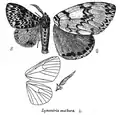Lymantria mathura
Lymantria mathura, the rosy gypsy moth, is a species of moth of the family Erebidae found in the Russian Far East, Nepal, Japan (Hokkaido, Honshu, Kyushu), the Korean Peninsula, northern India and China (at least Hebei, Heilongjiang, Jilin also in the west). The species was first described by Frederic Moore in 1866.
| Rosy gypsy moth | |
|---|---|
.jpg.webp) | |
| Lymantria mathura aurora | |
| Scientific classification | |
| Kingdom: | Animalia |
| Phylum: | Arthropoda |
| Class: | Insecta |
| Order: | Lepidoptera |
| Superfamily: | Noctuoidea |
| Family: | Erebidae |
| Genus: | Lymantria |
| Species: | L. mathura |
| Binomial name | |
| Lymantria mathura Moore, 1866 | |
| Synonyms | |
| |
The wingspan is 40–50 mm for males and 70–90 mm for females. Larvae have been recorded feeding on Terminalia, Shorea, Quercus, Mangifera, Eugenia and Mitragyna. It is considered a pest, since it is a major defoliator of deciduous trees.
Subspecies
- Lymantria mathura mathura
- Lymantria mathura aurora Butler, 1877 (Japan, Korea, Amur, China, Taiwan)
- Lymantria mathura subpallida Okano, 1959 (Taiwan)
Gallery
 Illustration
Illustration Female
Female Male
Male Lymantria mathura subpallida
Lymantria mathura subpallida
See also
References
- Hewitson, William C. & Moore, Frederic (1879). Descriptions of New Indian Lepidopterous Insects: From the Collection of the Late Mr. W.S. Atkinson, M.A., F.L.S., &c. The Asiatic Society of Bengal. OCLC 9625544 – via Internet Archive.
External links
- Biology and behavior of Lymantria mathura Moore (Lepidoptera: Lymantriidae)
- Data sheets on quarantine pests - Lymantria mathura
| Wikimedia Commons has media related to Lymantria mathura. |
This article is issued from Wikipedia. The text is licensed under Creative Commons - Attribution - Sharealike. Additional terms may apply for the media files.